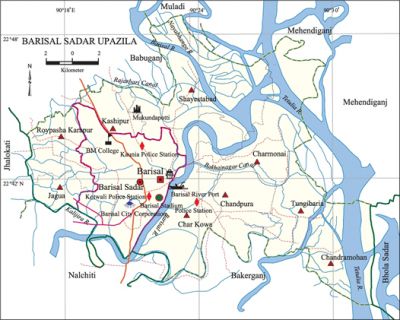Barisal Sadar Upazila
Barisal Sadar Upazila (barisal district) area 317.60 sq km, located in between 22°37' and 22°43' north latitudes and in between 90°16' and 90°32' east longitudes. It is bounded by babuganj, muladi and mehendiganj upazilas on the north, bakerganj and nalchity upazilas on the south, Mehendiganj and bhola sadar upazilas on the east, jhalokati sadar and Nalchity upazilas on the west.
Population Total 463032; male 243290, female 219742; Muslim 423619, Hindu 35810, Buddhist 3044, Christian 162 and others 397.
Water bodies Main rivers: kirtankhola, Kalijira, Nayabhanga, tentulia.
Administration Barisal Thana was formed on 18 January 1923. Barisal Paurasabha was formed in 1957 and it was turned into a city corporation in 2000.
| Upazila | ||||||||
| Municipality | Union | Mouza | Village | Population | Density (per sq km) | Literacy rate (%) | ||
| Urban | Rural | Urban | Rural | |||||
|
1 |
10 |
30 |
134 |
192 |
56 |
234783 |
228249 |
1374 |
| Municipality | ||||||||
|
Area (sq km) |
Ward |
Mahalla |
Population |
Density |
Literacy rate (%) | |||
|
19.74 |
30 |
56 |
192810 |
9767 |
74.03 | |||
| Upazila Town | ||||||||
|
Area (sq km) |
Mouza |
Population |
Density |
Literacy rate (%) | ||||
|
22.98 |
78 |
41973 |
1827 |
65.11 | ||||
| Union | ||||||||
| Name of union and GO code | Area (acre) | Population | Literacy rate (%) | |||||
| Male | Female | |||||||
|
Kashipur 69 |
5948 |
19659 |
18248 |
65.13 | ||||
|
Chandpura 32 |
5966 |
8877 |
8577 |
59.47 | ||||
|
Chandra Mohan 33 |
5732 |
7189 |
6657 |
44.28 | ||||
|
Char Kowa 43 |
9597 |
16165 |
14759 |
53.09 | ||||
|
Char Baria 34 |
5721 |
15651 |
15176 |
59.53 | ||||
|
Char Monai 51 |
10708 |
17838 |
15986 |
49.83 | ||||
|
Jagua 60 |
6555 |
19693 |
18042 |
68.04 | ||||
|
Tungibaria 94 |
5032 |
10477 |
10466 |
53.76 | ||||
|
Roy Pasha Karapur 77 |
5803 |
12441 |
11708 |
64.95 | ||||
|
Shayestabad 86 |
10481 |
11515 |
11098 |
45.28 | ||||
Source Bangladesh Population Census 2001, Bangladesh Bureau of Statistics.

Archaeological heritage and relics Kalibari of mukundadas, Shankar Math.
Historical events Many people were killed or wounded' when the British police conducted lathi charge in 1906 atthe conference of the Bangiya Provincial Parishad. On the issue of this incident' anti British movement spread over the whole of India. Armed rebellion started in this region with the establishment of Shankar Math in 1912. Barisal was liberated on 8 December 1971.
Marks of the War of Liberation Mass killing site 1.
Newspapers and periodicals Daily: Shahnama, Probashi, Gram Samachar, Ajker Barta, Ajker Kantha; periodicals: weekly Lokabani, Bakerganj Parikrama, Chirantan Bangla, Upakul, Samachar, Dipolo;' weekly: Paira, the River, Etibriti; extinct: Barisal Bartabaha (1870), Hitasadhini (1871), Banglar Ranjika (1873), Kashipur Nibasi (1881), Swadesh (1885), Bharat Hitoishi (1882), Barisal Hitoishi (1885), Bikash (1900), Sahayogi (1885), Praddip (1927).
Religious institutions Mosque 210, temple 30, church 5. Noted religious institutions: Baptist and Oxford Church, Saiyedunnesa Mosque (Jami Kasai).
Literacy rate and educational institutions Average literacy 64.8%; male 67%, female 62.3%. Educational institutions: university 1, polytechnic institute 1, medical college 1, physical education college 1, teachers' training centre 2, nursing institute 1, cadet college 1, college 15, secondary school 70, primary school 350. Noted educational institutions: Sher- Bangla Medical College, B M College (1889), Oxford Mission High School, Barisal Zila School.
Cultural organisations Library 3, circus party 2, theatre group 4, women's organisation 5, cinema hall 4, Shilpakala Academy 1, playground 11.
Main sources of income Agriculture 20.24%, non-agricultural labourer 5.53%, industry 1.10%, commerce 23.85%, transport and communication 6.44%, service 22.79%, construction 4.16%, religious service 0.42%, rent and remittance 2.56% and others 12.91%.
Ownership of agricultural land Landowner 50.60%, landless 49.40%; agricultural landowner: urban 43.19% and rural 58.10%.
Main crops Paddy, wheat, betel leaf, oil seed.
Extinct or nearly extinct crops Balam paddy, sugarcane, sesame.
Main fruits Coconut, Mango, litchi, betel nut, banana, amra.
Fisheries, dairies and poultries Dairy 5, poultry 160, hatchery 20.
Communication facilities Pucca road 120 km, semi-pucca road 85 km; airport 1.
Extinct or nearly extinct traditional transport Palanquin, bullock cart, horse carriage.
Manufactories Ice factory, flour mill, textile mill, oil mill, biscuit factory, pharmaceutical industry, welding factory, spinning factory.
Cottage industries Goldsmith, blacksmith, potteries, weaving, bidi factory, wood works.
Noted Hats, bazars and fairs Chandra Mohan Natun Bazar, Tungibaria Bazar, Lahar Bazar, Singher Kathi Bazar, Kanaipur Bazar, Maulvir Bazar, Talukdar Bazar, Goper Bazar, Steemarghat Bazar, Durgapur Bazar, Bangla Bazar, Saheber Hat, Chandra Mohan Hat, Aratdari Hat and Chawkbazar.
Main exports Hilsha fish, medicine, bidi, handicraft.
Access to electricity All the unions and wards of the upazila are under electrification net-work. However 60.66% dwellings have access to electricity.
Sources of drinking water Tube-well 77.37%, pond 4.19%, tap 15.62% and others 2.82%.
Sanitation 61.95% of dwelling households of the upazila use sanitary latrines and 32.50% of dwelling houses use non-sanitary latrines; 5.55% of households do not have latrine facilities.
Health centers Medical college hospital 1, hospital 2, upazila health complex 1, chest diseases hospital 1, clinic 10, nursing home 9.
NGO activities care, brac, caritas, asa, proshika. [Ushasi Eashika Khan]
References Bangladesh Population Census 2001, Bangladesh Bureau of Statistics; Cultural survey report of Barisal Sadar Upazila 2007.
